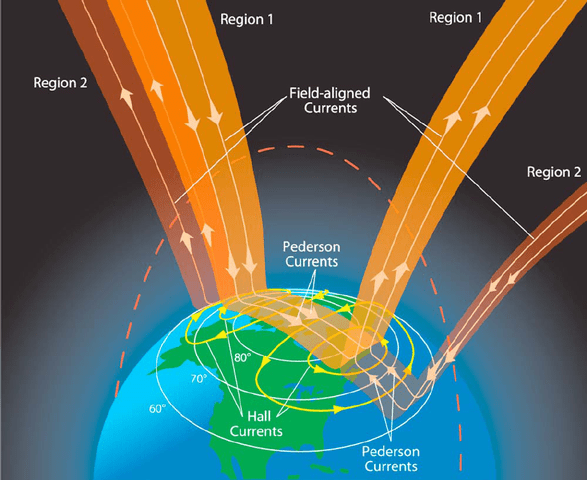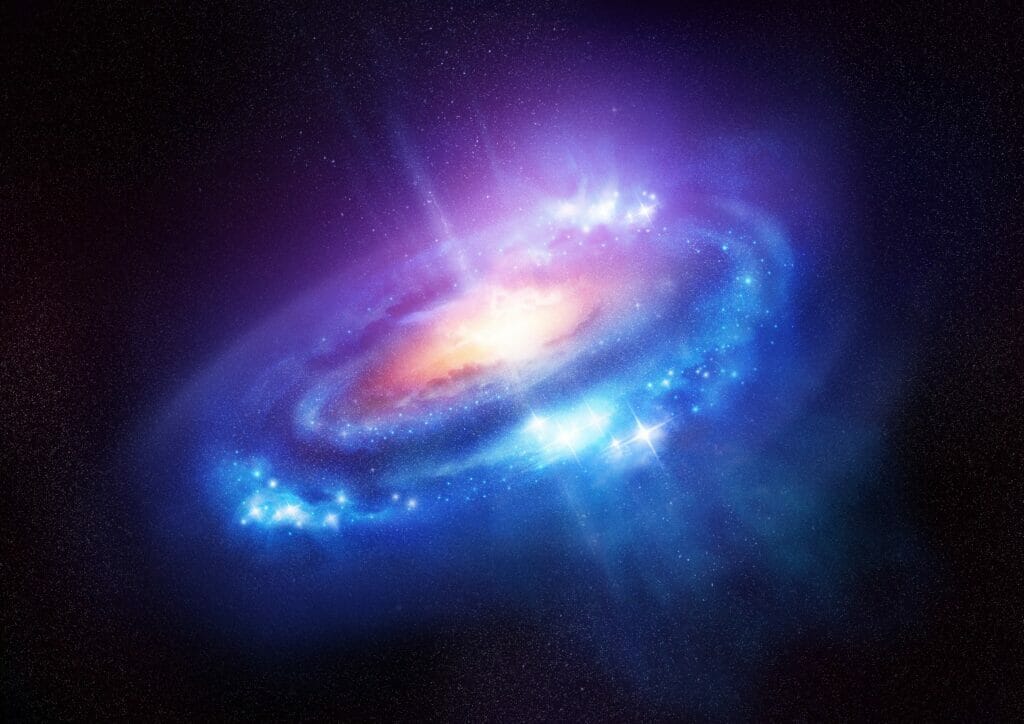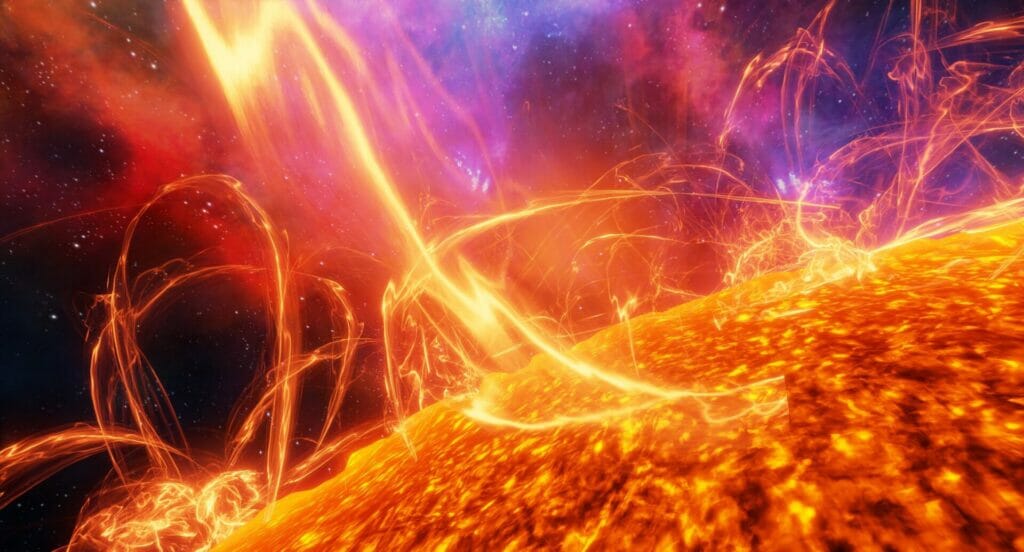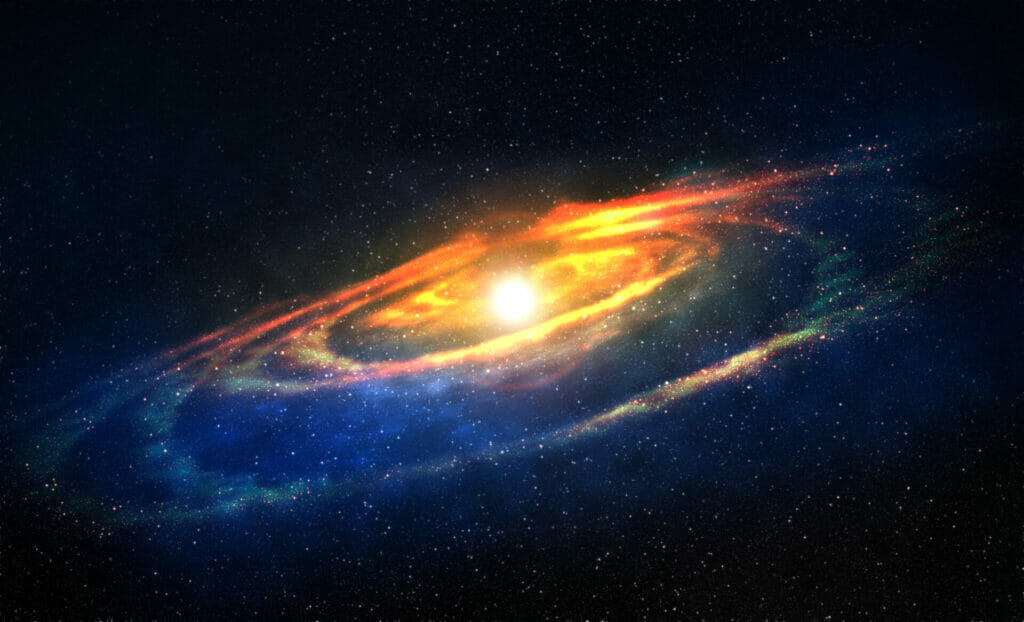The discovery by Alfven and his colleague Carl-Gunner Falthammar of the basic role played by filaments of current in the cosmos in the formation of structure from stars up to galaxies laid the basis for understanding filamentation in the plasma focus device. Similarly, LPPFusion Chief Scientist Eric Lerner’s research in the 1980’s using the formation of plasmoid in the DPF as a model for understanding quasars led to the formulation of a quantitative theory of the functioning of the DPF. This theory in turn predicted that the plasma focus could be used for pB11 fusion.
Plasma Near Earth

In the early years of the 20th century, Kristian Birkeland first hypothesized and later observed the filamentary currents high above the earth that make the aurora glow. The confirmation of that early observation by satellites in the 1970’s showed that currents in space moved along magnetic field lines. Today, detailed studies of near-earth plasma continue to reveal phenomena that, like the Birkeland filaments, can be applied to plasma in the laboratory, including those in fusion research.
Solar System Plasma
 Plasma processes were crucial in the formation of our solar system. In order for a body of gas to contract enough to form stars and planets its angular momentum or spin has to be slowed down. As Hannes Alfven discovered, this happens as electric currents start to flow inwards as the electrically conducting gas rotates in a magnetic field. The current forms filaments, which move through the surrounding plasma, accelerating it. At the same time the filaments, converging on the innermost parts of the plasma cloud, slow it down, allowing it to contract.
Today, plasma processes are visible in detail on the surface and in the atmosphere of the Sun. Giant filaments of plasma twist upwards from sunspots. When they kink together they can form plasmoids similar to those in the plasma focus, but on a far vaster scale, as in this dramatic video from NASA. These plasmoids release energy in the form of solar flares, which sometimes affect radio communications and electricity transmission on Earth.
Plasma processes were crucial in the formation of our solar system. In order for a body of gas to contract enough to form stars and planets its angular momentum or spin has to be slowed down. As Hannes Alfven discovered, this happens as electric currents start to flow inwards as the electrically conducting gas rotates in a magnetic field. The current forms filaments, which move through the surrounding plasma, accelerating it. At the same time the filaments, converging on the innermost parts of the plasma cloud, slow it down, allowing it to contract.
Today, plasma processes are visible in detail on the surface and in the atmosphere of the Sun. Giant filaments of plasma twist upwards from sunspots. When they kink together they can form plasmoids similar to those in the plasma focus, but on a far vaster scale, as in this dramatic video from NASA. These plasmoids release energy in the form of solar flares, which sometimes affect radio communications and electricity transmission on Earth. Galactic Plasma
 source
Center diagram: The Big bang Never Happened, Eric J. Lerner, Vintage
source
Center diagram: The Big bang Never Happened, Eric J. Lerner, Vintage

Another example is in the Cygnus Loop, a supernovae remnant 1,500 light years from Earth.
Quasar Plasma

Quasars are vast explosions, lasting millions of years, that occur in the centers of galaxies. They emit huge beams of energy, in only one direction at a time. (Smaller quasars are called “active galactic nuclei” or AGN.) While the most popular explanation for quasars is that they are giant black holes, their phenomena are duplicated on a much smaller scale by Herbig-Haro objects, which form as a stage in the birth of ordinary stars, so can’t involve black holes. In the 1980’s Eric Lerner, now LPPF’s Chief Scientist, published papers using the plasmoids formed in a dense plasma focus as an electromagnetic model for quasars. In this model, the quasars formed as a result of current converging at the center of a galaxy, much as in the laboratory, plasmoid form as the currents in a plasma focus converge. The theory allowed Lerner to make quantitative prediction about the behavior of plasma focus devices that led to the development of the current Focus Fusion research.
In April, 2019, a team of researchers claimed that new images they calculate from radio observations proved that the object at the center of galaxy M87 was a black hole. But Lerner, in a video series, raises the question “Is It Really a Black Hole?”
Plasma Cosmology
Plasma physics is essential for understanding the universe on all scales, including the largest, the realm of cosmology. Both Alfven and Lerner used plasma physics in their critiques of the popular Big Bang theory of cosmic history. It is quite possible that new discoveries in the cosmos in the future will again, as in the past, lead to new possibilities of technology. Indeed, discoveries in cosmology and fusion have been closely linked.
In May, 2014, Lerner and colleagues Renato Falomo and Riccardo Scarpa published new evidence indicating that the universe is not in fact expanding. “Questions and Answers on The Science of Surface Brightness” gives more technical details on this study. Here are biographical sketches of the research team members, and background on “The Growing Case against the Big Bang Theory”.
Lerner elaborated this research in a 2018 paper published in the leading journal Monthly Notices of the Royal Astronomical Society. The new study, titled “Observations contradict galaxy size and surface brightness predictions that are based on the expanding universe hypothesis”, finds that none of the published expanding-universe predictions of galaxy-size growth fit the actual data. All of the proposed physical mechanisms for galaxy growth, such as galaxy mergers, also contradict observations. However, the paper finds that the data are closely fit by the contrary hypothesis that the universe is not expanding, and that the redshift of light is caused by some other, currently unknown, process.
In 2020, Lerner presented to the American Astronomical Society meeting a new study showing that bedrock predictions of the Big Bang are contradicted by observations. The study looks at the origin and abundance of three key light elements that are hypothesized to have been created by the Big Bang. Precise amounts of helium, deuterium and lithium are predicted to have been formed by fusion reactions in the dense, extremely hot initial instants of the Big Bang.
For both lithium and helium, the study shows, observations of abundances in old stars now differ from predictions by more than a dozen standard deviations and the gap has been widening at an accelerating pace. The oldest stars have less than half the helium and less than one tenth the lithium than that predicted by Big Bang Nucleosynthesis theory. The lowest lithium levels observed are less than 1% that predicted by the theory. Indeed, the evidence is consistent with no helium or lithium having been formed before the first stars in our galaxy.
In June, 2022, Dr. Scarpa, and Lerner, submitted to arXiv, the online pre-print website, three papers critical of the validity of the Big Bang hypothesis: “Will LCDM cosmology survive the James Webb Space Telescope?” , “Observations of Large-Scale Structures Contradict the Predictions of the Big Bang Hypothesis But Confirm Plasma Theory”, and “The Big Bang Never Happened—A Reassessment of the Galactic Origin of Light Elements (GOLE) Hypothesis and its Implications”. Despite its policy of publishing all papers without review, arXiv refused to publish all three.
Twenty-four astronomers and astrophysicists protested this censorship in a petition. The protest is summarized in this press release, and the content of the three papers in this release, while the papers themselves are available here.
LPPFusion has started a new monthly video series on the Crisis in Cosmology exploring the scientific evidence that the dominant model of cosmology is invalid. Instead, the basic phenomena of the cosmos can be understood without an origin in time for the universe, and without exotic hypothetical entities like inflation, dark energy and dark matter. A second audio/podcast series on the implications of cosmology, called “Cosmic Connections” is also underway.
To dig deeper, here are technical papers from 2005 and earlier. Here are summaries of some discoveries from 2003, 2005 and 2007 and a reply to a critique from Ned Wright, a Big Bang defender.





